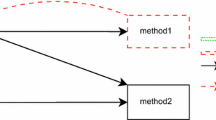Abstract
The paper presents a technology to effort reduction in developing test suites for industrial software products based on an incremental technology. The main problems to be solved by incremental technology are full automation design of test scenarios and significant reducing of test explosion. The proposed approach provides solutions to the mentioned problems through joint co-working of the designer and the customer with usage of formal models; and through methods of symbolic verification with automatic generation of test suites with the toolset VRS/TAT.
Similar content being viewed by others
References
Z.151: User requirements notation (URN)–Language definition. http://www.itu.int/rec/T-REC-Z.151-200811-I/en.
Crnkovic, I., Larsson, S., and Chaudron, M.R.V., Component-based development process and component lifecycle, CIT, 2005, vol. 13, no. 4, pp. 321–327.
Jisa Laurentiu, D., Component based development methods, in Comparison, Computer Systems and Technologies, 2004, pp. 1–6.
Le, H. and Kathayat, S.B., A framework to support the development of collaborative components, Lect. Notes Bus. Inf. Process., 2011, vol. 83, pp. 378–384.
Sammi, R., Rubab, I., and Qureshi, M.A., Formal specification languages for real-time systems, Information Technology: International Symposium Proceedings (ITSIM-2010), 2010, vol. 3, pp. 1642–1647.
Kolano, P.Z., Dang, Z., and Kemmerer, R.A., The design and analysis of real-time systems using the astral software development environment, Ann. Software Eng., 1999, vol. 7, pp. 177–210.
Bollella, G., Brosgol, B., Dibble, P., and Furr, S., The Real-Time Specification for JavaTM. www.cs.rice.edu/taha/teaching/04F/RAP/cache.
Anneke, J.W., The Object Constraint Language, Precise Modeling with UML, Addison-Wesley, 1999.
Baranov, S., Kotlyarov, V., Letichevsky, A., and Drobintsev, P., The technology of Automation Verification and Testing in Industrial Projects, Proc. of St. Petersburg IEEE Chapter, International Conference, May 18–21, St. Petersburg, 2005, pp. 81–86.
Anureev, I.S., Baranov, S.N., Beloglazov, D.M., Bodin, E.V., Drobintsev, P.D., Kolchin, A.V., Kotlyarov, V.P., Letichevsky, A.A., Letichevsky, A.A., Jr., Nepomnyashchii, V.A., Nikiforov, I.V., Potienko, S.V., Priima, L.V., and Tyutin, B.V., Tools of integrated technology for analysis and verification of telecom application specs, Tr. SPIIRAN, 2013, vol. 3, no. 26, pp. 349–383.
Hoare, C.A.R., Communicating Sequential Processes, Prentice Hall, 1985.
Letichevsky, A.A., Kapitonova, J.V., Kotlyarov, V.P., Letichevsky, O.O., Volkov, V.V., Baranov, S.N., and Weigert, T., Basic protocols, message sequence charts, and the verification of requirements specifications, Proc. of ISSRE04 Workshop on Integrated Reliability Engineering (ISSRE04: WITUL), IRISA, Rennes, 2004.
Kolchin, A.V., Development of tools for testing formal models of asynchronous systems, Cand. Sci. (Phys.-Math.) Dissertation, Kiev, 2009.
Baranov, S., Kotlyarov, V., and Weigert, T., Verifiable coverage criteria for automated testing, Lect. Notes Comput. Sci., 2012, vol. 7083, pp. 79–89.
Letichevsky, A.A., Kapitonova, J.V., Kotlyarov, V.P., Letichevsky, A.A., Jr., Nikitchenko, N.S., Volkov, V.A., and Weigert, T., Insertion modeling in distributed system design, Software Probl. (Probl. Program.), 2008, pp. 13–38.
Mesarovich, M.D. and Takakhara, Y., General Systems Theory: Mathematical Foundations, Elsevier Science, 1975.
Drobintsev, P., Kotlyarov, V., Nikiforov, I., and Letichevsky, A., A formal approach for generation of test scenarios based on guides, 5th Workshop Program Semantics, Specification and Validation: Theory and Applications, Yekaterinburg, 2013, pp. 31–41.
Letichevsky, A.A., Godlevsky, A.B., Letichevsky, A.A., Jr., Potienko, S.V., and Peschanenko, V.S., Properties of predicate transformer of VRS system, Cybernetics Syst. Anal., 2010, vol. 4, pp. 3–16.
Godlevsky, A.B. and Potienko, S.V., Backward transformation of formulas in symbolic modeling: From the result to the source formula, Probl. Program., 2010, vol. 4, pp. 363–368.
Dijkstra, E.W. and Scholten, C.S., Predicate Calculus and Program Semantics, Springer-Verlag, 1990.
Drobintsev, P.D., Nikiforov, I.V., and Kotlyarov, V.P., Translation of UCM real-time constructs into basic protocols, Univ. J., 2013, no. 5, pp. 193–201.
Author information
Authors and Affiliations
Corresponding author
Additional information
Original Russian Text © P.D. Drobintsev, V.P. Kotlyarov, I.V. Nikiforov, A.A. Letichevsky, 2014, published in Modelirovanie i Analiz Informatsionnykh Sistem, 2014, Vol. 21, No. 6, pp. 144–154.
The article was translated by the authors.
About this article
Cite this article
Drobintsev, P.D., Kotlyarov, V.P., Nikiforov, I.V. et al. Incremental approach to the technology of test design for industrial projects. Aut. Control Comp. Sci. 50, 486–492 (2016). https://doi.org/10.3103/S014641161607004X
Received:
Published:
Issue Date:
DOI: https://doi.org/10.3103/S014641161607004X




